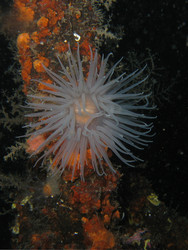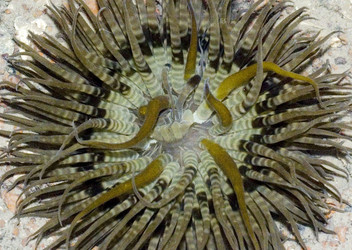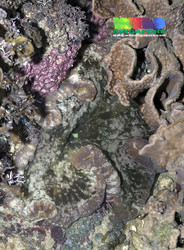Actiniaria
Sea Anemones
Characteristics
Anthozoa (Dodecacorallia), the proximal end of which is either rounded, physa-like or forms a more or less well-developed, flat pedal disc, without or with basilar muscles. Column smooth or provided with verrucae, tenaculi, vesicles, marginal spherules or pseudospherules or other specialisations [sic] of variable structure, often divisible into different regions, sometimes with spirocysts and with nematocyst batteries, rarely with ectodermal muscles. Margin indistinct or distinct, sometimes separated from the tentacles by a more or less developed fosse. Tentacles retractile or not, usually arranged hexamerously in alternating cycles but sometimes in radial series at least in the case of those communicating with the endocoels, usually simple, more rarely knobbed at the apex or branched or provided with papillae, exceptionally absent. Sphincter absent or present, endodermal to mesogloeal. Oral disc usually circular, but, sometimes drawn out into lobes of varying appearance. Actinopharynx shorter or longer usually with siphonoglyphs, typically two in number but varying from one to several. Siphonoglyphs usually connected with directive mesenteries, but very exceptionally the single siphonoglyph is more or less wholly separated from the actinopharynx. Pairs of mesenteries usually arranged in cycles, usually 6 + 6 + 12 etc. , a variable number of pairs perfect. From the stage with 6 pairs or later the subsequent mesenteries grow either (a) from the pedal disc upwards, or (b) from the oral disc downward, or (c) from the limbus and margin about simultaneously. Retractors of mesenteries of variable appearance from diffuse to circumscribed. Parietobasilar muscles more or less strong, in elongate individuals usually forming a well differentiated parietal muscle together with the parietal part of the longitudinal mesenterial muscles. Basilar muscles present or absent. Ciliated tracts of the filaments as a rule present. Acontia present or absent. Gonads situated at the same level as the filaments; their distribution variable, occasionally present only on the mesenteries of the last cycle, which sometimes lack filaments. Cnidom: spirocysts, atrichs, holotrichs, microbasic b- and p-mastigophors, microbasic and macrobasic amastigophors (these types never simultaneously present in any single individual).References
Carlgren, O. 1949. A Survey of the Ptychodactiaria, Corallimorpharia and Actiniaria. Kungl. Svenska Vetenskapsakadamiens Handlingar, series 4, volume 1, number 1.
Title Illustrations

| Scientific Name | Protanthea simplex |
|---|---|
| Location | Drøbak, Norway |
| Specimen Condition | Live Specimen |
| Source | Sealoch Anemone / Korallnellik (IMG_4391) |
| Source Collection | Flickr |
| Image Use |
 This media file is licensed under the Creative Commons Attribution-NonCommercial-NoDerivs License - Version 2.0. This media file is licensed under the Creative Commons Attribution-NonCommercial-NoDerivs License - Version 2.0.
|
| Copyright |
© 2006 Asbjørn Hansen

|
| Scientific Name | Boloceroides mcmurrichi |
|---|---|
| Location | Beting Bronok, Singapore |
| Specimen Condition | Live Specimen |
| Source | IMG_6038 |
| Source Collection | Flickr |
| Image Use |
 This media file is licensed under the Creative Commons Attribution-NonCommercial-ShareAlike License - Version 2.0. This media file is licensed under the Creative Commons Attribution-NonCommercial-ShareAlike License - Version 2.0.
|
| Copyright | © 2008 budak |
| Scientific Name | Cryptodendrum adhaesivum |
|---|---|
| Location | Singapore |
| Specimen Condition | Live Specimen |
| Source | Pizza sea anemone (Cryptodendrum adhaesivum) |
| Source Collection | Flickr |
| Image Use |
 This media file is licensed under the Creative Commons Attribution-NonCommercial-NoDerivs License - Version 2.0. This media file is licensed under the Creative Commons Attribution-NonCommercial-NoDerivs License - Version 2.0.
|
| Copyright | © 2000 Ria Tan |
About This Page
The information provided on this page is based on Oscar Carlgren's 1949 catalog.Copyright © 1949 Swedish Academy of Sciences.
Please note that Carlgren's text contains a number of errors, and much of the information is now out of date. An update of the catalog is currently under preparation in Daphne Fautin's laboratory, and the results of this work will be incorporated in future versions of this page.
Keyboarding of Carlgren's catalog was done as part of a project to create an electronic database of the sea anemones of the world, funded by NSF Grant DEB9521819, awarded to Daphne G. Fautin. This grant is in the program Partnerships to Enhance Expertise in Taxonomy (PEET). Susanne Hauswaldt, Katherine Pearson, and April Wakefield-Pagels contributed to the keyboarding effort.
Correspondence regarding this page should be directed to Daphne G. Fautin at
fautin@ku.edu
Page copyright © 2000
All Rights Reserved.
Citing this page:
Tree of Life Web Project. 2000. Actiniaria. Sea Anemones. Version 01 January 2000 (temporary). http://tolweb.org/Actiniaria/17649/2000.01.01 in The Tree of Life Web Project, http://tolweb.org/












 Go to quick links
Go to quick search
Go to navigation for this section of the ToL site
Go to detailed links for the ToL site
Go to quick links
Go to quick search
Go to navigation for this section of the ToL site
Go to detailed links for the ToL site